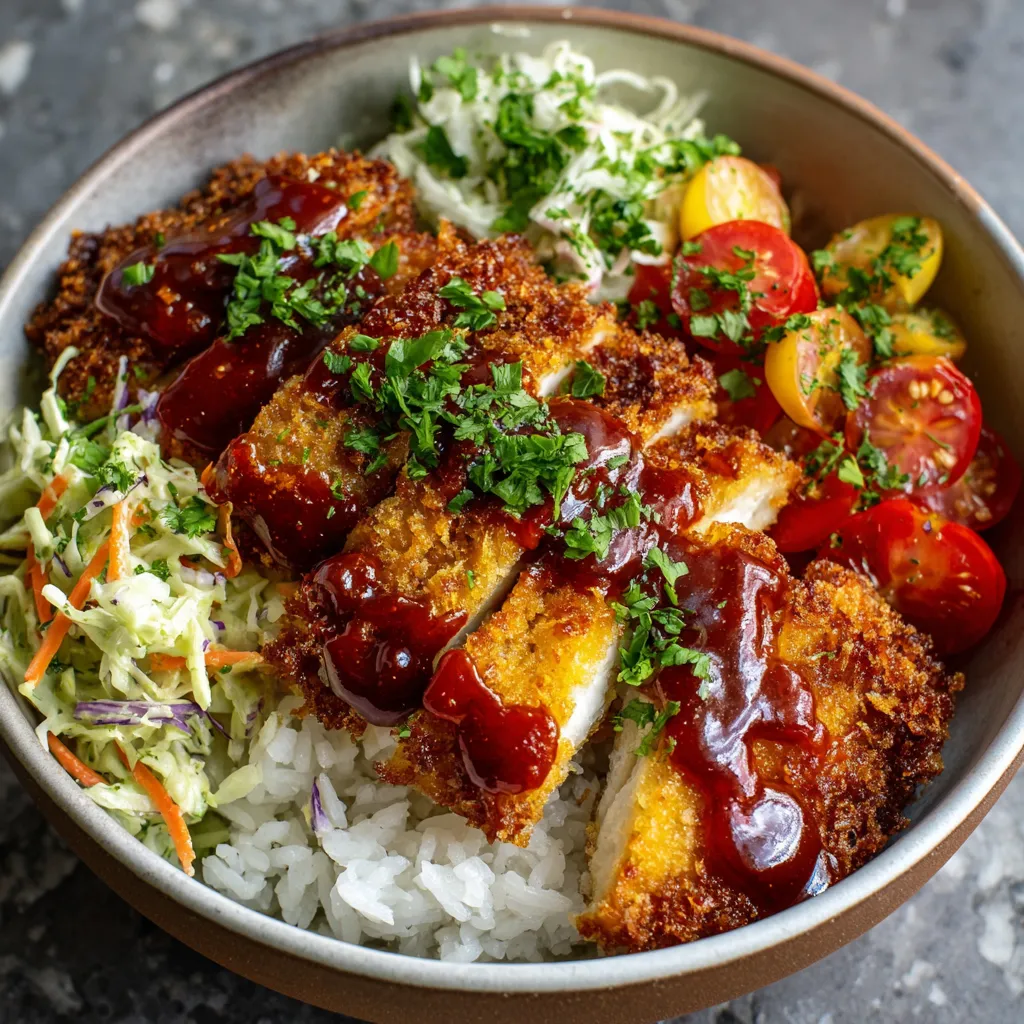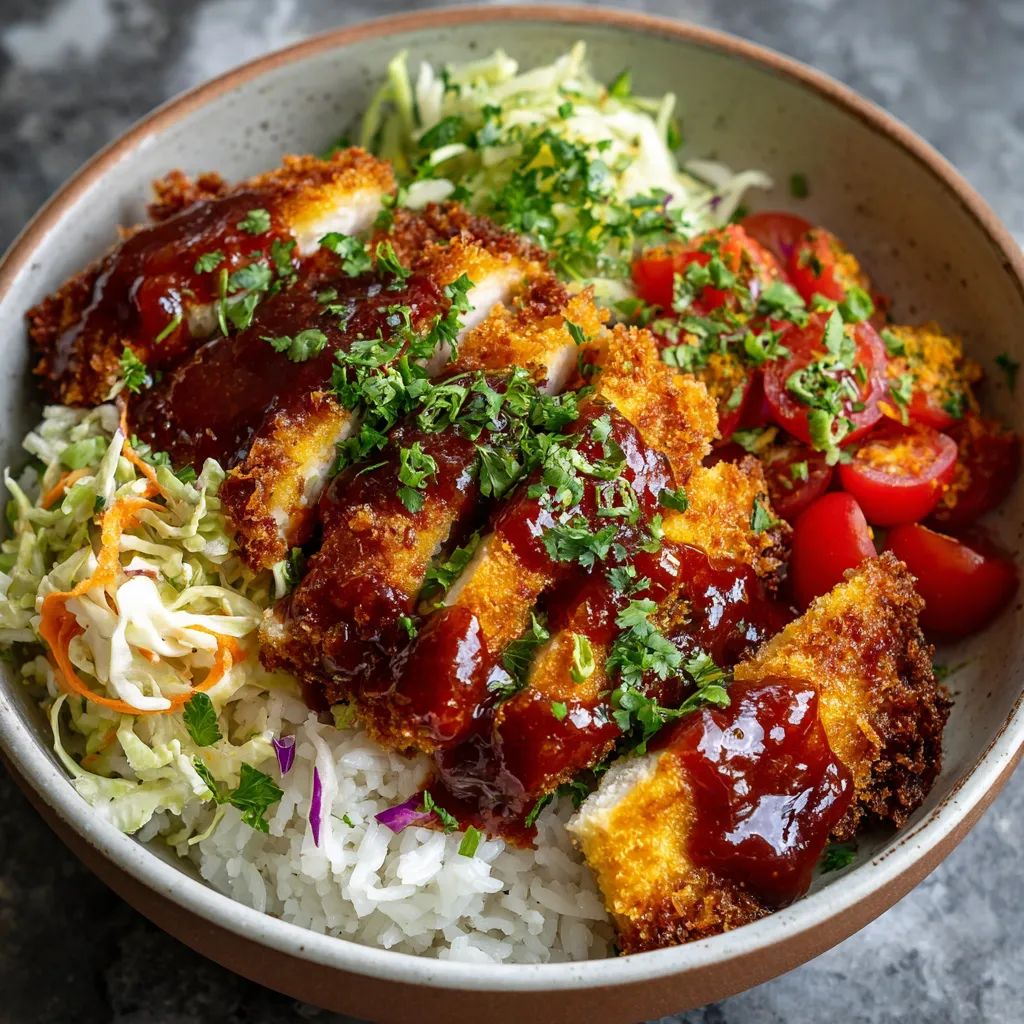 Bookmark
Bookmark
This Japanese-inspired katsu bowl has become my weeknight obsession when I crave something crispy yet comforting. The contrasting textures of crunchy panko coating against tender meat and fluffy rice create a perfectly balanced meal that feels like restaurant dining without leaving home.
I discovered katsu bowls during my first trip to Japan and became determined to recreate that perfect crunch at home. After numerous attempts tweaking the breading technique, this version finally captures that authentic golden crust that makes katsu so irresistible.
Ingredients
- Boneless pork chops or chicken breasts these provide the foundation for katsu and should be pounded thin for even cooking and maximum tenderness
- All purpose flour creates the first layer that helps egg adhere properly to the meat surface
- Large egg acts as the essential binding agent that ensures breadcrumbs stick perfectly to create that signature crust
- Panko breadcrumbs the secret to authentic Japanese crunch factor traditional breadcrumbs simply cannot replicate this airy texture
- Ketchup forms the base of tonkatsu sauce providing both sweetness and acidity
- Worcestershire sauce adds complex umami depth that makes the sauce irresistible
- Soy sauce provides essential saltiness and color to balance the sauce profile
- Mirin introduces authentic Japanese sweetness with subtle rice wine notes
- Japanese short grain rice sticky texture perfectly complements crispy katsu and holds sauce beautifully
Step-by-Step Instructions
- Prepare the meat
- Pound pork chops or chicken breasts between plastic wrap to about ¼ inch thickness for even cooking. Season generously with salt and pepper on both sides allowing the seasoning to penetrate the meat for maximum flavor.
- Set up breading station
- Arrange three shallow bowls in sequence first with flour seasoned with a pinch of salt and pepper second with beaten egg whisked until smooth and third with panko breadcrumbs spread evenly. This assembly line approach prevents messy hands and ensures consistent coating.
- Master the breading technique
- Using one hand for dry ingredients and one for wet dredge meat first in flour shaking off excess then coat completely in egg allowing extra to drip off before pressing firmly into panko ensuring breadcrumbs adhere to every surface. Pat gently to secure coating.
- Achieve perfect frying
- Heat oil to exactly 350°F using a thermometer if possible the right temperature prevents greasy katsu. Add cutlets carefully without overcrowding cooking 3 to 4 minutes per side until deeply golden. The sizzle should be steady but not aggressive indicating proper heat.
- Rest and slice properly
- Transfer fried katsu to a wire rack not paper towels to maintain maximum crispness. Allow to rest for 3 minutes before cutting against the grain into ½ inch strips this preserves the juiciness and makes for easier eating.
- Prepare authentic sauce
- Whisk all sauce ingredients vigorously until completely smooth with no lumps of garlic powder or mustard. The sauce should have a glossy appearance and coat the back of a spoon perfectly balance is key between sweet tangy and savory elements.
- Assemble with intention
- Layer components strategically starting with hot rice followed by freshly shredded cabbage then sliced katsu and finally drizzle sauce in a zigzag pattern rather than drowning the crispy coating. Finish with precisely scattered green onions and sesame seeds for visual appeal and flavor complexity.
 Bookmark
Bookmark
The secret ingredient that elevates my tonkatsu sauce is the touch of Dijon mustard. My Japanese friend's grandmother taught me this slight modification that adds a subtle complexity most restaurant versions lack. When my children first tried this recipe, they declared it better than our local Japanese restaurant—a culinary victory I still proudly remember.
Perfect Rice Technique
Japanese short-grain rice requires proper washing to remove excess starch. Rinse the rice at least three times until the water runs almost clear. This crucial step prevents gumminess and creates the perfect texture foundation for your katsu bowl. After cooking, allow the rice to steam covered for an additional 10 minutes before fluffing with a wooden paddle. This resting period allows moisture to distribute evenly throughout every grain, resulting in the ideal sticky yet fluffy consistency that Japanese cuisine demands.
Cabbage Preparation Matters
The shredded cabbage served alongside katsu isn't just a garnish but an essential component that balances the richness of the fried cutlet. Slice cabbage as thinly as possible using a sharp knife or mandoline, then soak in ice water for 10 minutes. This simple technique creates the signature crisp, refreshing texture that cleanses the palate between bites of katsu. Pat completely dry before serving to prevent diluting your sauce or making the katsu soggy. For an authentic touch, squeeze a few drops of lemon juice over the cabbage just before serving.
Cultural Context
Tonkatsu originated during Japan's Meiji era when the country began embracing Western culinary influences. The dish represents the perfect fusion of European cooking techniques with Japanese sensibilities. Traditionally, tonkatsu is served with mustard and tonkatsu sauce on the side rather than poured over, allowing diners to control the flavor intensity. In Japanese households, katsu is considered a treat rather than everyday fare due to its deep-fried preparation. Serving it in bowl form with rice is a modern adaptation that makes this beloved dish more accessible for weeknight meals while honoring its cultural significance.
Storage Solutions
Prepare components separately for best results when storing leftovers. Keep cooked katsu uncovered in the refrigerator to maintain some crispness, then reheat in a 350°F oven for 5-7 minutes rather than microwave. The sauce can be refrigerated for up to two weeks in an airtight container and actually improves in flavor after a day or two as ingredients meld together. Cooked rice should be cooled completely before refrigerating and refreshed with a sprinkle of water when reheating to restore moisture. For meal prep, consider keeping the cutlets uncooked but breaded in the refrigerator for up to 24 hours before frying for freshest results.
Your Questions Answered About This Recipe
- → Can I use other proteins besides pork or chicken for katsu?
Absolutely! While pork and chicken are traditional, you can make delicious katsu using turkey cutlets, firm white fish fillets, or even extra-firm tofu slices. Just ensure your protein is sliced to about 1/2-inch thickness for proper cooking, and adjust frying times accordingly.
- → How do I get the panko breadcrumbs to stick properly?
For perfect panko adhesion, follow the proper order: first dredge your seasoned cutlet in flour, then dip fully in beaten egg, and finally press firmly into panko breadcrumbs on both sides. Let the breaded cutlets rest for 5-10 minutes before frying to help the coating set.
- → What's a good substitute for mirin in the tonkatsu sauce?
If you don't have mirin, you can substitute it with 1 tablespoon of honey or 1 tablespoon of sugar dissolved in 1 tablespoon of sake or dry white wine. In a pinch, even 2 teaspoons of sugar mixed with 1 tablespoon water will provide the necessary sweetness and body to your sauce.
- → Can I make katsu without deep-frying?
Yes! For a healthier version, you can shallow-fry in about 1/4 inch of oil, or use an air fryer at 390°F (200°C) for about 12-15 minutes, turning halfway through. You can also bake breaded cutlets in a conventional oven at 400°F (200°C) for about 20 minutes, though the color won't be as golden.
- → What sides pair well with katsu bowls?
Traditional accompaniments include finely shredded cabbage, pickled vegetables (tsukemono), miso soup, and Japanese-style potato salad. For a complete meal, you might also add steamed edamame, cucumber salad with rice vinegar dressing, or simple blanched vegetables like broccoli or snap peas.
- → How can I store leftover katsu and sauce?
Store leftover cooked katsu in an airtight container in the refrigerator for up to 2 days. Reheat in a 350°F (175°C) oven for 10 minutes to restore some crispiness. The tonkatsu sauce can be stored separately in the refrigerator for up to 2 weeks. For best results, keep the sauce, meat, and rice in separate containers until serving.
